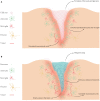A Prosperous Application of Hydrogels With Extracellular Vesicles Release for Traumatic Brain Injury
- PMID: 35720072
- PMCID: PMC9201053
- DOI: 10.3389/fneur.2022.908468
A Prosperous Application of Hydrogels With Extracellular Vesicles Release for Traumatic Brain Injury
Erratum in
-
Corrigendum: A prosperous application of hydrogels with extracellular vesicles release for traumatic brain injury.Front Neurol. 2022 Aug 3;13:984818. doi: 10.3389/fneur.2022.984818. eCollection 2022. Front Neurol. 2022. PMID: 35989910 Free PMC article.
Abstract
Traumatic brain injury (TBI) is one of the leading causes of disability worldwide, becoming a heavy burden to the family and society. However, the complexity of the brain and the existence of blood-brain barrier (BBB) do limit most therapeutics effects through simple intravascular injection. Hence, an effective therapy promoting neurological recovery is urgently required. Although limited spontaneous recovery of function post-TBI does occur, increasing evidence indicates that exosomes derived from stem cells promote these endogenous processes. The advantages of hydrogels for transporting drugs and stem cells to target injured sites have been discussed in multitudinous studies. Therefore, the combined employment of hydrogels and exosomes for TBI is worthy of further study. Herein, we review current research associated with the application of hydrogels and exosomes for TBI. We also discuss the possibilities and advantages of exosomes and hydrogels co-therapies after TBI.
Keywords: biocompatible materials; exosomes; hydrogels; therapy; traumatic brain injury.
Copyright © 2022 Chen, Lin and Yan.
Conflict of interest statement
The authors declare that the research was conducted in the absence of any commercial or financial relationships that could be construed as a potential conflict of interest.
Figures

Similar articles
-
Combined bioscaffold with stem cells and exosomes can improve traumatic brain injury.Stem Cell Rev Rep. 2020 Apr;16(2):323-334. doi: 10.1007/s12015-019-09927-x. Stem Cell Rev Rep. 2020. PMID: 31808037 Review.
-
Hyaluronan-based hydrogel integrating exosomes for traumatic brain injury repair by promoting angiogenesis and neurogenesis.Carbohydr Polym. 2023 Apr 15;306:120578. doi: 10.1016/j.carbpol.2023.120578. Epub 2023 Jan 18. Carbohydr Polym. 2023. PMID: 36746568
-
Cell-Derived Exosomes as Therapeutic Strategies and Exosome-Derived microRNAs as Biomarkers for Traumatic Brain Injury.J Clin Med. 2022 Jun 5;11(11):3223. doi: 10.3390/jcm11113223. J Clin Med. 2022. PMID: 35683610 Free PMC article. Review.
-
Effect of exosomes derived from multipluripotent mesenchymal stromal cells on functional recovery and neurovascular plasticity in rats after traumatic brain injury.J Neurosurg. 2015 Apr;122(4):856-67. doi: 10.3171/2014.11.JNS14770. Epub 2015 Jan 16. J Neurosurg. 2015. PMID: 25594326 Free PMC article.
-
Intravenous infusion of the exosomes derived from human umbilical cord mesenchymal stem cells enhance neurological recovery after traumatic brain injury via suppressing the NF-κB pathway.Open Life Sci. 2022 Mar 17;17(1):189-201. doi: 10.1515/biol-2022-0022. eCollection 2022. Open Life Sci. 2022. PMID: 35415238 Free PMC article.
Cited by
-
Hydrogel-encapsulated extracellular vesicles for the regeneration of spinal cord injury.Front Neurosci. 2023 Dec 14;17:1309172. doi: 10.3389/fnins.2023.1309172. eCollection 2023. Front Neurosci. 2023. PMID: 38156267 Free PMC article. Review.
-
Biomaterials in Traumatic Brain Injury: Perspectives and Challenges.Biology (Basel). 2023 Dec 29;13(1):21. doi: 10.3390/biology13010021. Biology (Basel). 2023. PMID: 38248452 Free PMC article. Review.
-
Human umbilical cord mesenchymal stem cell-derived exosome suppresses programmed cell death in traumatic brain injury via PINK1/Parkin-mediated mitophagy.CNS Neurosci Ther. 2023 Aug;29(8):2236-2258. doi: 10.1111/cns.14159. Epub 2023 Mar 8. CNS Neurosci Ther. 2023. PMID: 36890626 Free PMC article.
-
Unraveling the Emerging Niche Role of Extracellular Vesicles (EVs) in Traumatic Brain Injury (TBI).CNS Neurol Disord Drug Targets. 2024;23(11):1357-1370. doi: 10.2174/0118715273288155240201065041. CNS Neurol Disord Drug Targets. 2024. PMID: 38351688 Review.
-
Exosomes and Biomaterials: In Search of a New Therapeutic Strategy for Multiple Sclerosis.Life (Basel). 2022 Sep 11;12(9):1417. doi: 10.3390/life12091417. Life (Basel). 2022. PMID: 36143453 Free PMC article. Review.
References
Publication types
LinkOut - more resources
Full Text Sources

